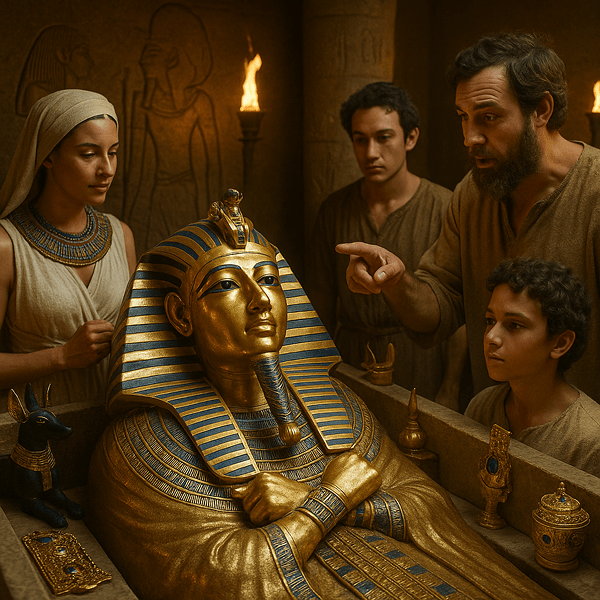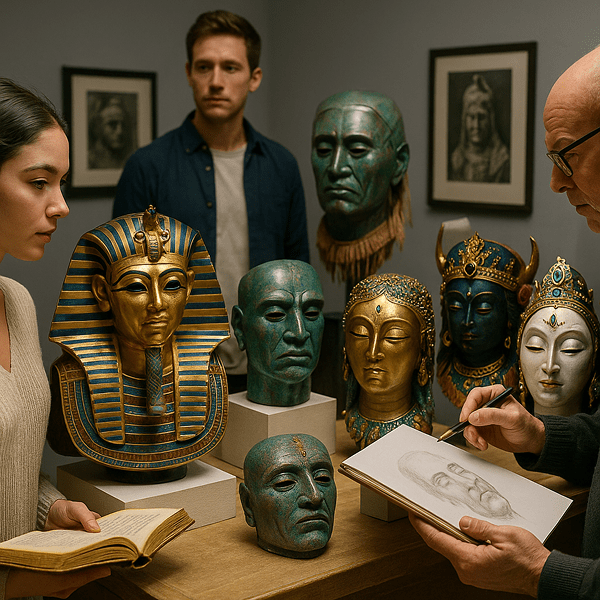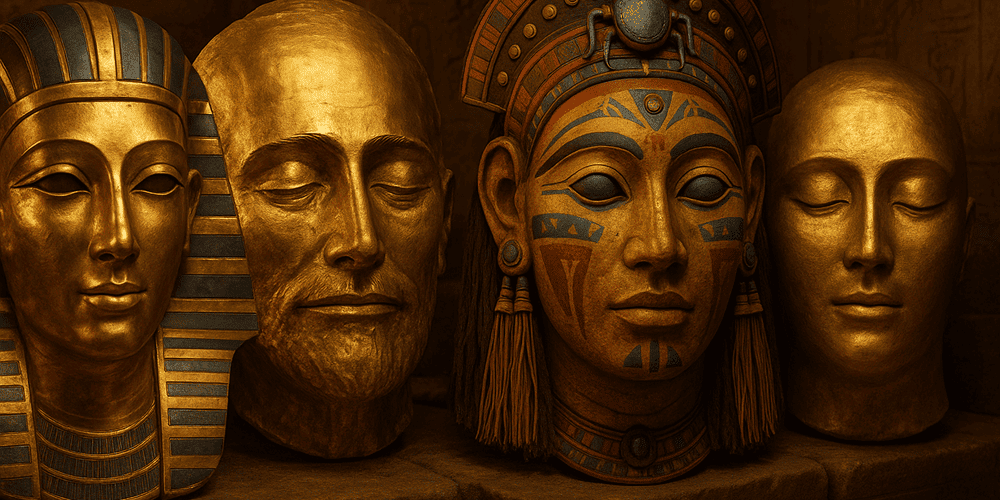Afterlife Masks — also known as funerary or burial masks — are among the most enigmatic and evocative artifacts of ancient funerary traditions. Designed to accompany the deceased into the next world, these masks are striking for their idealized human features, stylized eyes, serene expressions, and elaborate decorative motifs. They may be crafted from gold, cartonnage, wood, stone, or plaster, and are often painted, gilded, or inlaid with precious stones. Afterlife Masks are especially prominent in Ancient Egypt, the Aegean (Mycenaean Greece), and various cultures of Africa and the Americas, each contributing unique forms and functions to the tradition. Their origins date back to some of the earliest civilizations, and their enduring presence in museum collections and cultural memory attests to their powerful role in the rituals surrounding death and the afterlife.
Historical Origins of Afterlife Masks
The history of Afterlife Masks is deeply rooted in humanity’s quest to understand and navigate the mysteries of death. The term “afterlife mask” refers to a mask placed over the face of the deceased, symbolizing both protection and transformation. The word “mask” itself has ancient roots — from the Arabic “maskhara,” meaning buffoon or mockery, evolving in European languages to signify a covering or likeness. Early examples of funerary masks appear in Predynastic Egypt and reach their zenith in the golden Mummy Masks of the New Kingdom (e.g., the mask of Tutankhamun, c. 1323 BCE). In Mycenaean Greece, hammered gold Death Masks — such as the Mask of Agamemnon — served a similar purpose, honoring elite individuals. Over time, the design and function of Afterlife Masks evolved with changing religious beliefs, burial practices, and artistic styles. The Greco-Roman period in Egypt saw the rise of the Fayum mummy portraits — lifelike painted masks that blend Egyptian, Greek, and Roman influences. Archaeological finds, inscriptions, and written records provide a rich context for understanding the evolution of these masks, their ritual use, and their shifting symbolism.
Cultural Significance and Symbolism of Afterlife Masks
Afterlife Masks are loaded with cultural, religious, and symbolic meaning. In Ancient Egypt, the mask was seen as a magical device that ensured the deceased’s safe journey into the afterlife, providing a recognizable face for the soul (ka) and linking the individual to divine figures such as Osiris. The serene, idealized features of the mask conveyed an image of eternal youth and perfection, while the materials and colors used (gold for divinity, blue for rebirth, green for regeneration) reflected the hope for resurrection and spiritual transformation. Myths and legends often surrounded the power of the mask to ward off evil or grant immortality, and funerary texts described the mask as a protective talisman. Socially, Afterlife Masks reinforced hierarchies and commemorated the achievements or lineage of the deceased. In some cultures, masks were believed to help the dead communicate with ancestors or the gods, ensuring harmony between the worlds of the living and the departed.

Materials and Craft Techniques of Afterlife Masks
The creation of Afterlife Masks was an art form requiring both technical skill and spiritual knowledge. Traditional materials varied: gold for royalty and elites, cartonnage (linen or papyrus soaked in plaster) for officials and commoners, wood, stone, or painted plaster for other classes. Artisans used chisels, knives, molds, and natural pigments to shape and decorate the masks. Surface treatments included gilding, painting, inlaying with glass, faience, or stones, and carving symbolic motifs like the uraeus (cobra), vulture, or sacred beard. Each region and era developed its own techniques: Mycenaean masks were hammered from thin sheets of gold, while Egyptian masks might be molded and painted in lifelike detail. Color symbolism was paramount — gold for eternity, blue for the heavens, black for the fertile earth, red for vitality. Decorative elements often included religious inscriptions or amulets, further enhancing the mask’s spiritual potency.
Functions and Uses of Afterlife Masks
Afterlife Masks served as both ritual objects and artistic masterpieces. Their primary function was funerary — placed over the face (and sometimes the upper chest) of the deceased, they protected the body and soul, ensured recognition in the afterlife, and provided a vessel for spiritual rebirth. In some cultures, masks were used during funeral rites, processions, or ceremonies to honor ancestors and invoke blessings. Over time, the use of Afterlife Masks changed — Greco-Roman Egypt replaced sculpted masks with painted portraits, and in some societies, the tradition faded as religious beliefs evolved. Today, Afterlife Masks are no longer used in burial but are preserved in museums, studied by scholars, and sometimes recreated for educational or cultural projects. While their use in festivals or theater was rare, their visual language has inspired artists, filmmakers, and designers, leaving a legacy that bridges the ritual and the aesthetic. For those interested in related traditions, Death Masks offer another fascinating perspective on the intersection of art and remembrance.
Regional Variations of Afterlife Masks
Afterlife Masks display remarkable regional and chronological variation. In Ancient Egypt, styles ranged from the golden masks of the New Kingdom to cartonnage and wood masks of later periods. The Fayum portraits of Roman Egypt are notable for their realism and blending of cultural motifs. Mycenaean Greece produced hammered gold masks with stylized but individualized features, reflecting local beliefs about the afterlife. In Africa, masks used in funerary rites may be carved from wood or painted with symbolic colors and motifs, each reflecting unique cosmologies. In South America, Andean cultures also produced funerary masks in gold, silver, or copper, often with animal or supernatural features. Each region’s masks express distinct attitudes toward death, identity, and immortality, yet all share the desire to honor the dead and ensure a safe passage to the afterlife.
Famous Examples and Collections of Afterlife Masks
Some of the world’s most celebrated Afterlife Masks are housed in major museum collections. The golden mask of Tutankhamun in the Egyptian Museum (Cairo), the Mask of Agamemnon in the National Archaeological Museum (Athens), and the Fayum mummy portraits in the British Museum and the Louvre are iconic examples. Museums such as the Metropolitan Museum of Art (New York), Neues Museum (Berlin), and the Museo Egizio (Turin) also feature significant collections. Important archaeological finds from Saqqara, Mycenae, and the Fayum have expanded our understanding of mask styles and burial practices. Private collectors and digital resources, including toddmasks.com, offer virtual access to high-resolution images and expert commentary, making these artifacts available to a global audience.
Influence of Afterlife Masks on Art and Culture
Afterlife Masks have had a profound influence on the visual arts, literature, and design. Their lifelike yet idealized forms have inspired generations of artists — from ancient sculptors to Picasso and modern conceptualists. In literature and cinema, afterlife masks symbolize the mystery of death, the quest for immortality, and the enduring connection between past and present. Modern designers adapt mask motifs for jewelry, fashion, and stage design, blending ancient symbolism with contemporary expression. The continued display and study of Afterlife Masks in museums and educational programs help preserve the memory of ancient beliefs and artistic achievements, fostering dialogue about mortality and human creativity.

Contemporary Status and Preservation of Afterlife Mask Traditions
Today, Afterlife Masks are preserved as invaluable artifacts of cultural heritage. Museums, universities, and cultural organizations support research, conservation, and public education, while advances in imaging and restoration science protect these fragile objects. Artisans and scholars create detailed replicas for exhibitions and study, and online platforms like toddmasks.com provide accessible resources for global audiences. Though not used in modern funerary practice, Afterlife Masks inspire artists and educators, who reinterpret their visual language in new media and conceptual art. Preservation efforts focus on documentation, ethical collecting, and sharing knowledge with future generations.
Collecting and Acquiring Afterlife Masks
Authentic ancient Afterlife Masks are rare and usually belong to museum or institutional collections. High-quality replicas, casts, and educational models can be acquired from museum shops, specialist artisans, or academic suppliers. Prices depend on craftsmanship, material, provenance, and historical accuracy. Collectors are advised to seek expert authentication, comply with legal and ethical standards, and support responsible sources. Toddmasks.com offers expert guidance on collecting, authentication, and understanding the context and value of afterlife masks. Responsible collecting ensures respect for the spiritual and historical significance of these remarkable artifacts.
